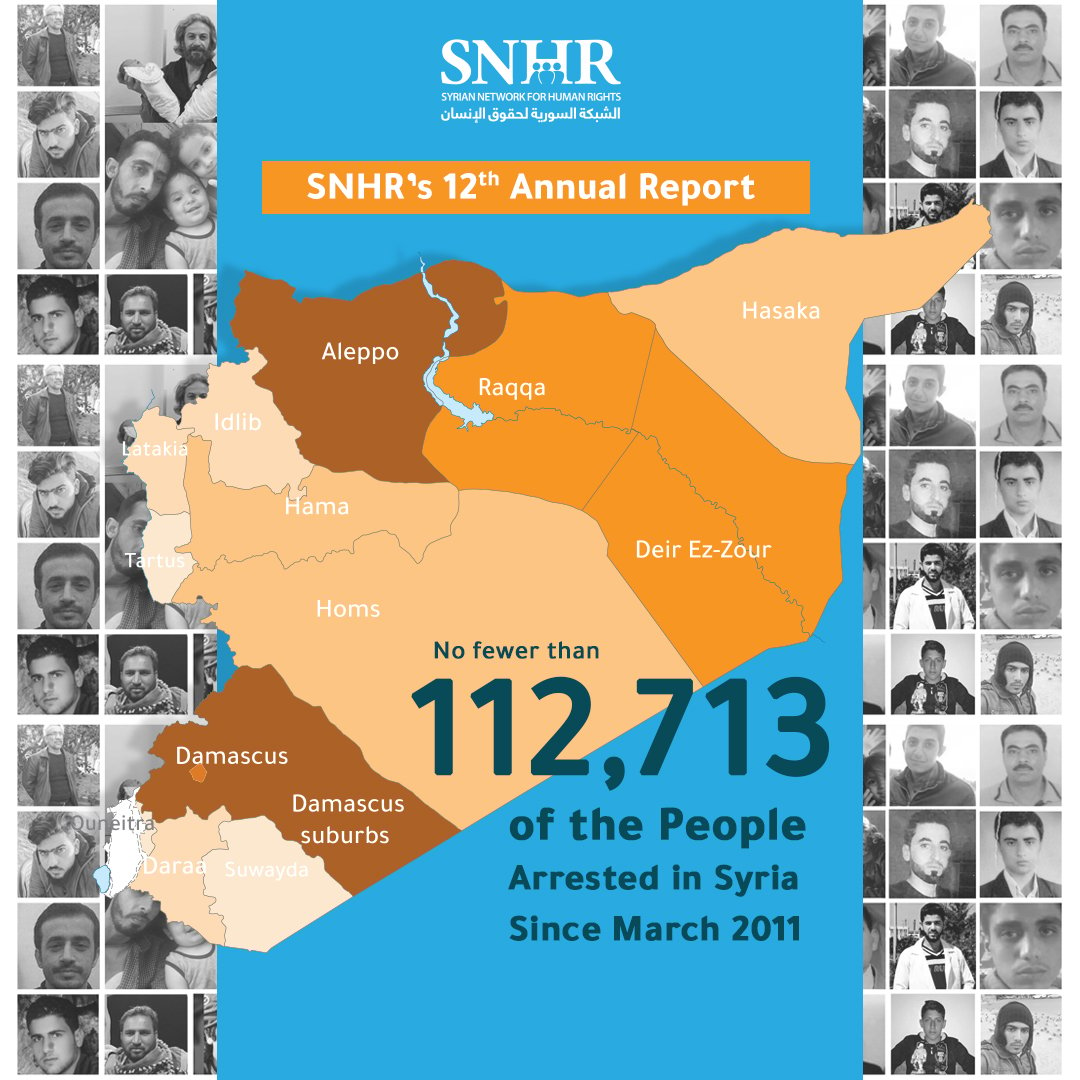No fewer than 112,713 of the People Arrested in Syria Since March 2011, Including 3,105 Children and 6,698 Women, Are Still Forcibly Disappeared

Languages
Available In
Press release: (Download the full report below)
The Hague – The Syrian Network for Human Rights (SNHR) today released its 12th annual report on enforced disappearance in Syria, in observance of the International Day of the Disappeared that marks August 30 of every year. The group noted that no fewer than 112,713 of the people arrested in Syria since March 2011 are still forcibly disappeared, including 3,105 children and 6,698 women.
The44-page report outlines numerous incidents of enforced disappearance and includes many accounts of victims’ families. The report notes that the ongoing incidence of enforced disappearances in Syria, perpetrated by the various parties to the conflict and controlling forces in the country, is one of the most complex and monstrous violations that has haunted the nation for 12 years to date. This is because the phenomenon of enforced disappearance in Syria involves a sequential string of gross violations, from arbitrary arrest to unlawful detention and deprivation of personal freedom, as well as torture in its various physical, psychological, and sexual forms, and exceptional trials involving summary and secretive procedures. Enforced disappearance, by its very nature, usually takes place hidden from view, with forcibly disappeared persons lacking all and any forms of protection and legal and human rights monitoring. That is to say that their most fundamental rights are deliberately denied in detention centers, where they are additionally subjected to agonizing and severe torture and absolute medical negligence. Moreover, while all parties to the conflict have resorted to use of enforced disappearance as a means to intimidate society, spread fear, and consolidate control, the Syrian regime’s security machine uses enforced disappearance in a widespread and systematic manner, viewing it as an extremely effective instrument with which to subjugate and crush any aspirations for change, freedom, and democracy. Through its ruthless use of enforced disappearance, the Syrian regime has massively surpassed all other parties to the conflict by inflicting and perpetuating use of this terrible strategy against all groups in Syrian society, whether men, women or children, the very old or very young, without showing the slightest shred of human decency or consideration and without making any exception for the most vulnerable victims.
Fadel Abdul Ghany, SNHR Executive Director, says:
“Enforced disappearance is one of the most prominent reasons why millions of IDPs and refugees refuse to return to their homes. In today’s Syria, forcibly disappeared persons account for approximately five percent of the total Syrian population numbered at roughly 24 million. Five percent is an extremely and alarmingly high percentage, and is the worst in the world. This is without mentioning the other agonies that forcibly disappeared persons suffer, such as torture, seizure of properties and lands, and family disintegration.”
The report outlines the toll of enforced disappearance since the beginning of the popular uprising for freedom in Syria in March 2011 up until August 2023. The report mainly focuses on the violations committed by SNHR’s team during the past year, August 2022 to August 2023. In this, the report stresses that the Syrian regime continues to tamper with laws and records and continues to record more forcibly disappeared persons as dead in the civil registry records. Additionally, the report presents an outline of the most notable figures who hold leadership positions in the Syrian regime’s security agencies, security/committees, and military bodies, which are involved in enforced disappearance crimes against tens of thousands of Syrians.
The report mainly draws upon SNHR’s regularly updated database that we created and which we’ve developed over the past 12 years. The report also draws upon interviews with enforced disappearance victims’ families from across Syria, with 18 accounts included in this report that have been gathered directly, and not taken from any second-hand sources.
As the report further clarifies, the newly formed UN institution on missing persons in Syria will undoubtedly galvanize efforts at both the Syrian and international levels in support for resolving the missing persons issue, and perhaps lead to the creation of a central database with a platform to enable tens of thousands of families to safely contact it. While we welcome this development, there are, nonetheless, a number of concerns regarding this new body that need to be addressed. First, in its current development stage, the new body does not have a clearly defined role in ensuring the release of arbitrarily arrested detainees; second, there is no explicit text referring to holding those responsible for perpetrating violations in Syria accountable; third, the predictable lack of cooperation by the parties to the conflict will complicate its mandate in revealing the fate of the missing.
The report also reveals that SNHR is in regular and continuous contact with the UN Working Group on Enforced or Involuntary Disappearances, the UN Special Rapporteur on torture and other cruel, inhuman or degrading treatment or punishment, the UN Special Rapporteur on Promotion and Protection of Human Rights while Countering Terrorism- Specific work on victims of terrorism, and the UN Special Rapporteur on the right of everyone to the enjoyment of the highest attainable standard of physical and mental health on these cases. Since March 2011, the report further reveals, SNHR has briefed the UN Working Group on no fewer than 593 enforced disappearance cases; including those of dozens of women, children, and whole families. In addition, we are still documenting and processing hundreds of cases in accordance with our rigorous methodology.
As the report reveals, no fewer than 155,604 of the people arrested in Syria between March 2011 and August 2023, including 5,213 children and 10,176 women (adult female), are still under arrest and/or forcibly disappeared by the parties to the conflict and controlling forces. Of these, the Syrian regime holds 135,638 individuals, including 3,693 children and 8,478 women, while no fewer than 8,684 individuals, including 319 children and 255 women, have been forcibly disappeared by ISIS. Furthermore, 2,514, including 46 children and 45 women, are still detained/forcibly disappeared at the hands of Hay’at Tahrir al-Sham (HTS).
Meanwhile, no fewer than 4,064 individuals, including 364 children and 874 women, are still detained/forcibly disappeared at the hands of all armed opposition factions/Syrian National Army (SNA), in addition to 4,704 individuals, including 791 children and 524 women, who are still detained/forcibly disappeared at the hands of the Kurdish-led Syrian Democratic Forces (SDF).
Moreover, no fewer than 112,713 of the individuals arrested between March 2011 and August 2023, including 3,105 children and 6,698 women (adult female), are still forcibly disappeared by the parties to the conflict and controlling forces in Syria. Of those, the Syrian regime is holding or has forcibly disappeared 96,103 individuals, including 2,327 children and 5,739 women, while no fewer than 8,684 individuals, including 319 children and 255 women, have been forcibly disappeared by ISIS. Furthermore, the report notes that 2,162 people, including 17 children and 32 women, are still detained/forcibly disappeared at the hands of HTS. Meanwhile, no fewer than 2,943 individuals, including 256 children and 563 women, are still detained/forcibly disappeared at the hands of all armed opposition factions/SNA, since 2011 in all of the areas currently and previous under their control, in addition to 2,821 individuals, including 186 children and 109 women, who are still detained/forcibly disappeared at the hands of the SDF.
The report further stresses that all the amnesty decrees issued by the Syrina regime have completely failed to secure the release of any significant number of detainees and forcibly disappeared persons. These decrees have had no real effect or led to any transparency, or to any mechanisms that might ensure the release of all detainees and forcibly disappeared persons or compensate them. Put plainly, these decrees are a cruel political deception used to promote the appearance of the Syrian regime’s taking action in order to alleviate international pressure on it while in reality further exploiting and extorting the families of detainees and forcibly disappeared persons. In this context, the report notes that no fewer than 7,351 individuals (6,086 civilians and 1,265 military servicemen) have been released from the Syrian regime’s various civilian and military prisons and detention centers across Syria in relation to the 22 amnesty decrees issued by the regime between March 2011 and October 2022. Of those 6,086 civilians, 349 are women and 159 were children at the time of their arrest. We have recorded no releases in relation to the most recent amnesty decree issued by the Syrian regime on December 21, 2022, also known as Legislative Decree No. 24 of 2022.
The report also provides a running count of the toll of forcibly disappeared persons since March 2011, and its distribution by year and according to the parties to the conflict. As the report shows, the first four years of the popular uprising for freedom saw the largest waves of enforced disappearance, with 2012 being the worst, followed by 2013, then 2011, and then 2014.
Additionally, the report shows a distribution of enforced disappearances by governorate (i.e., where enforced disappearances took place, rather than the victim’s governorate of origin) at the hands of the parties to the conflict and controlling forces in Syria. According to the report, Rural Damascus (Rif Dimshaq) governorate saw the highest number of enforced disappearances, followed by Aleppo, then Damascus, and then Deir Ez-Zour.
The report further notes that, since the beginning of 2018, the Syrian regime has been recording some of the forcibly disappeared persons as dead in the civil registry records. The report reveals that the Syrian regime has disclosed the deaths of no fewer than 1,609 individuals, including 24 children, 21 women, and 16 medical personnel, in the civil registry records since the beginning of 2018 up until August 2023. The causes of these victims’ deaths were not provided in these records, while their bodies have not been returned to their families, and their deaths were not announced when they took place. The report stresses that the Syrina regime has employed its institutions at multiple levels to carry out these unlawful practices and tamper with the civil records of the disappeared, from the ministries of interior and justice to the officials at the civil registry offices across all of Syria.
Furthermore, the report stresses that arbitrary arrests and enforced disappearances are two of the most serious risks facing internally displaced persons (IDPs) and refugees returning to regime-held areas, even for those who have never been involved in any dissident activism. As the report reveals, since the beginning of 2014, up until August 2023, no fewer than 3,376 refugees, including 246 children and 212 women (adult female), who returned from their countries of asylum or residence to their original areas of residence in Syria have been arrested by Syrian regime forces. A total of 2,094 of these detainees were released, while 926 of the remaining 1,282 detainees, most of whom returned from Lebanon, Türkiye, and Jordan, have gone on to be classified as forcibly disappeared. In the same period, no fewer than 989 internally displaced persons (IDPs) who returned to regime-held areas were also arrested, including 22 children and 19 women. The Syrian regime released 246 of these IDPs, while of the remaining 743, a total of 538 have gone on to become forcibly disappeared persons. We have also documented that the Syrian regime re-arrested some of the 246 released detainees in order to forcibly conscript them into the military.
Moreover, the report stresses that hundreds of figures holding leadership positions in the Syrian regime’s security agencies, military divisions, and military and security committees are or have been involved in the violations committed against the Syrian people and the Syrian state since 2011. Enforced disappearance has been practiced in a systematic and widespread way under the direct supervision of the Syrian regime’s entire leadership hierarchy, starting with the President of the Republic, who directly controls the ministries of interior and defense, the National Security Bureau, and their various security agencies and security and military committees. In this context, it should be noted that decisions on appointments, promotions, and transfers of officials heading security agencies are taken through the orders and decrees issued exclusively by the President of the Republic. In this context, the report provides names and brief summaries on some of the figures most heavily involved in forcibly disappearing tens of thousands of Syrians as documented on SNHR’s database on the perpetrators of violations.
The report notes that the Syrian regime has failed to uphold any of its obligations dictated by the international conventions and instruments it has ratified, in particular the International Covenant on Civil and Political Rights. Furthermore, the Syrian regime has violated multiple articles in the Syrian Constitution written and adopted by the very same regime. In this, the Syrian regime continues to detain hundreds of thousands of detainees who have been held for many years with no arrest warrant or charges. These detainees are also denied any opportunity to appoint a lawyer or receive visits from their families. Approximately, 68.25 percent of all detainees have gone on to become forcibly disappeared. These detainees’ families have not been informed of their whereabouts. If the desperately worried families try to inquire about the fate or whereabouts of their loved ones, security branches deny any knowledge of them, and the family members are themselves at risk of persecution for asking.
The report further stresses that enforced disappearance has been practiced as part of a widespread attack against all groups of the civilian population, with the Syrian regime being the main perpetrator of this crime by a vast margin compared to other parties to the conflict. In the Syrian regime’s case, this constitutes a crime against humanity according to Article 7 of the Rome Statute of the International Criminal Court, and is also a war crime according to Article 8 of the same instrument since it was committed “as part of a plan or policy” primarily by the Syrian regime in its response to the popular uprising for freedom.
The report adds that other parties to the conflict have practiced enforced disappearance, albeit not with the same standardized character and prevalence as that of the Syrian regime. There is also a difference in terms of the quantity and distribution of cases. However, the cases of HTS and ISIS bear a similarity to the Syrian regime’s in terms of the wide distribution and systematic nature of cases.
The report calls on the UN Security Council and the UN to protect tens of thousands of detainees and persons forcibly disappeared by the Syrian regime from the certain risk of dying due to torture, and to save those who are still alive. In addition, the report calls on the UN Security Council and the UN to work to reveal the fate of forcibly disappeared persons in tandem with, or before launching further rounds of any political process, and establish a strict timetable to reveal their fate.
The report also calls on the UN Working Group on Enforced or Involuntary Disappearances to increase the levels of manpower working on the forcibly disappeared persons issue at the office of the Special Rapporteur on cases of enforced disappearance in Syria in light of the magnitude and massive level of enforced disappearance in the country, in addition to making a number of other recommendations.


